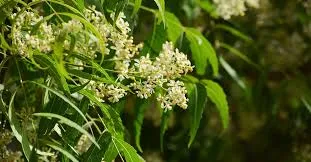Azadirachta Indica வேப்ப மரம்
http://www.sidhhaherbs.blogspot.com
herbal-medicine-alternative
Neem trees are now grown commercially in more than 30 countries and have even been successfully introduced into warmer regions of North America. Because of its climatic versatility, Neem trees are being used in many reforestation projects around the world. A worldwide foundation, known as the Neem Foundation, helps make people aware of the values of Neem and other natural "green" products for a better and healthier lifestyle. The use of Neem tree pesticides, as noted above, is creating a greater awareness of the benefits of natural, non-chemical solutions for our environment.
Among the many natural plants and herbs that people in India use for their medicinal properties, the Neem tree (L. Azadirachta Indica) is one of the most beneficial for natural or Ayurvedic medicine. Found over most of the forested regions of the Indian Subcontinent, as well as in other countries of similar climatic conditions, the Neem tree can thrive in climates that range from hot, or tropical (45 degrees Celsius) to altitudes of semi-temperate, higher altitude regions, with temperatures slightly above freezing. Used in Indian Ayurvedic medicine for more than 2,000 years, the Neem tree's bark, Neem leaves, Neem seeds, and roots can be made into various medicinal remedies for a wide range of ailments, ranging from anti-hemorrhoids and loss of appetite to leprosy and other skin disorders.
 Neem oil is a vegetable oil pressed from the fruits and seeds of the neem (Azadirachta indica), an evergreen tree that is endemic to the Indian subcontinent and has been introduced to many other areas in the tropics. It is the most important of the commercially available products of neem for organic farming and medicines.
Neem oil is a vegetable oil pressed from the fruits and seeds of the neem (Azadirachta indica), an evergreen tree that is endemic to the Indian subcontinent and has been introduced to many other areas in the tropics. It is the most important of the commercially available products of neem for organic farming and medicines.
http://http://www.sidhhaherbs.blogspot.com
Neem trees are now grown commercially in more than 30 countries and have even been successfully introduced into warmer regions of North America. Because of its climatic versatility, Neem trees are being used in many reforestation projects around the world. A worldwide foundation, known as the Neem Foundation, helps make people aware of the values of Neem and other natural "green" products for a better and healthier lifestyle. The use of Neem tree pesticides, as noted above, is creating a greater awareness of the benefits of natural, non-chemical solutions for our environment.
Neem oil is generally red as blood and has a rather strong odor that is said to combine the odors of peanut and garlic. It is comprised mainly of triglycerides and contains many triterpenoid compounds, which are responsible for the bitter taste. It is hydrophobic in nature and in order to emulsify it in water for application purposes, it must be formulated with appropriate surfactants.
Azadirachtin is the most well-known and studied triterpenoid in neem oil. The azadirachtin content of neem oil varies from 300ppm to over 2500ppm depending on the extraction technology and quality of the neem seeds crushed. Neem oil also contains steroids (campesterol, beta-sitosterol, stigmasterol).
| Average composition of neem oil fatty acids | ||
|---|---|---|
| Common Name | Acid Name | Composition range |
| Omega-6 | Linoleic acid | 6-16% |
| Omega-9 | Oleic acid | 25-54% |
| Palmitic acid | Hexadecanoic acid | 16-33% |
| Stearic acid | Octadecanoic acid | 9-24% |
| Omega-3 | Alpha-linolenic acid | ?% |
| Palmitoleic acid | 9-Hexadecenoic acid | ?% |
Methods of extraction
The method of processing is likely to affect the composition of the oil, since the methods used, such as pressing (expelling) or solvent extraction are unlikely to remove exactly the same mix of components in the same proportions. The neem oil yield that can be obtained from neem seed kernels also varies widely in the literature from 25% to 45%.
The oil can be obtained through pressing (crushing) the seed kernel both through cold pressing or through a process incorporating temperature controls.
Neem seed oil can also be obtained by solvent extraction of the neem seed, fruit, oil, cake, or kernel. A large industry in India extracts the oil remaining in the seed cake using hexane. This solvent-extracted oil is of a lower quality as compared to cold-pressed oil and is mostly used for soap manufacturing.
வேப்பம் புண்ணாக்கு
கேள்விப்பட்டிருக்கிறீர்களா?
Neem cake is a by-product obtained in the solvent extraction process for neem oil.
Neem oil and other neem products such as neem leaves and neem tea should not be consumed by pregnant women, women trying to conceive, or children.
There is some evidence that internal medicinal use may be associated with liver damage in children.[2]
Formulations made of neem oil also find wide usage as a biopesticide for organic farming, as it repels a wide variety of pests including the mealy bug, beet armyworm, aphids, cabbage worm, thrips, whiteflies, mites, fungus gnats, beetles, moth larvae, mushroom flies, leafminers, caterpillars, locust, nematodes and the Japanese beetle. Neem oil is not known to be harmful to mammals, birds, earthworms, or some beneficial insects such as butterflies, honeybees, and ladybugs if it is not concentrated directly into their area of habitat or on their food source. It can be used as a household pesticide for ants, bedbugs, cockroaches, houseflies, sandflies, snails, termites, and mosquitoes both as a repellent and larvicide (Puri 1999). Neem oil also controls black spots, powdery mildew, anthracnose, and rust (fungus).Thanks, wiki
physicianpackiam
http://www.sidhhaherbs.blogspot.com (31)



No comments:
Post a Comment